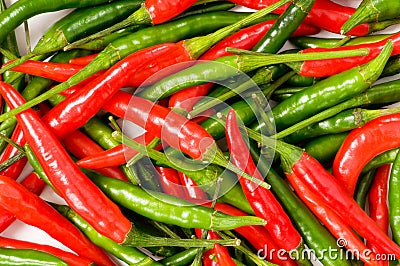We all love our chiles. But how much do you actually know about our spicy little friends?

Fortunately, there are entire websites devoted to chilis so you can brush up on your knowledge. And New Mexico State has its own institute devoted to these peppers! Here is a list of their most commonly asked chili pepper questions. How many did you already know the answer to? Which ones surprised you?
Frequently Asked Questions
Q. How do you get the burning to stop?
A. The best way to ease the burning sensation is to drink milk, or eat any dairy product. A substance found in dairy products known as casein helps to disrupt the burning sensation. If you get the oil on your skin you may want to rub it with rubbing alcohol first then soak in milk, this seems to alleviate the burning. If you get capsaicinoids in your eyes the only thing you can do is repeatedly rinse with water.
Q. Where did chile peppers originate?
A. All chile peppers are Western Hemisphere crops, varieties listed from the Eastern hemisphere have origins in the west. Chile peppers are believed to have originated in what is known as a "nuclear area" in South America bordered by the mountains of southern Brazil and to the east by Bolivia.
Q. What are bird's eye peppers?
A. This variety is also known as Tepin, Chiltepin, Chile Piquin or Bird Pepper all similar and somewhat interchangeable varieties of wild peppers that still exist today. These are the small chile pepper fruits found growing wild or in kitchen gardens. The small size resembles a "birds eye" and are eaten by birds, the natural dispersal agent for wild chile peppers. There is also a misnomer with the name "bird's eye." Some individuals have called Asian types and Tabasco peppers birds eye which are not true bird's eye chile peppers.
Q. What does "heat" do for the chile pepper plant? Or in other words, why did evolution produce hot peppers?
A. Chile peppers evolved heat to protect the fruits from being eaten by mammals. Birds, the natural dispersal agent of chile peppers, cannot feel the heat, the seeds then pass, intact, through the birds digestive system and thus, can disseminate the seeds naturally. Unfortunately, when mammals eat chile peppers, the seeds are destroyed in the digestive tract, so the heat is to discourage rodents from eating the fruits in the wild.
Q. What is the string of red chile peppers seen all over the southwest United States?
A. This stringing process is called a "ristra." In the early days of chile pepper cultivation, farmers would takes partially dehydrated red chile peppers from their fields, string them into ristras and hang them outside their homes to finish drying. Hanging a ristra outside the front door of a house is said to bring the home good luck.
Q. What is the difference between a green chile pepper and a jalapeño?
A. All chile peppers belong to the nightshade family (Solanaceae) along with tomatoes, potatoes, tobacco, and eggplants. The difference between green chile peppers, which usually means a New Mexican type, and a jalapeño is the shape of the pod, flavor, and heat level.
Q. What is a "Hatch" pepper?
A. There really is no chile pepper variety named "Hatch", but rather is the area where the chile peppers grow. The town of Hatch, New Mexico is located about 40 miles north of Las Cruces, NM. The town of Hatch, New Mexico has marketed their Hatch grown chile peppers over the years in a way that "Hatch" chile peppers are in high demand all over the world.
Q. Can you eat ornamental chile peppers?
A. Yes, as long as it is a true Capsicum. Many times breeders are considering the aesthetics of the plant when breeding new cultivars of ornamentals thus the cultivar ends up usually being very hot and without much flavor. This leads the nursery industry to label the plants "non-edible".
Q. What is the hottest chile pepper in the world?
A. Up until September of 2006, the Guinness Book of World Records listed the world's hottest chile pepper as the 'Red Savina' habanero. The new hottest chile pepper in the world is the ‘Bhut Jolokia' with a Scoville rating three times that of the ‘Red Savina,' at 1,001,304 Scoville Heat Units (SHU).
Q. What makes chile peppers hot?
A. The heat in a chile pepper is caused by a group of alkaloids called capsaicinoids. There are currently 15 different capsaicinoids making up capsaicin, meaning there are endless possibilities for flavor and heat combinations.
Q. Is there any way to take the heat out of a jalapeño?
A. You could carefully remove the placenta (midrib), where the capsaicinoids are located. The orange or yellow color seen on the placenta is the exact location of the capsaicinoids. By removing the placenta, the heat is removed.
Q. Are chile peppers perennial plants?
A. In nature wild chile pepper plants are perennials, growing for up to 10 years. If the growing conditions are favorable (no frost or freezing temperatures), such as in southern California, Texas and Florida, they can be grown as perennials, sometimes growing for many years.
Read more http://www.chilepepperinstitute.org/frequently_asked_questions.php



0 comments:
Post a Comment